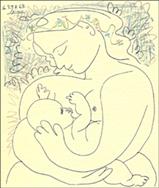BFHI Training Materials • BFHI Resources

2003 Estate of Pablo Picasso/Artists Rights Society (ARS), New York
|
The Baby-friendly Hospital Initiative (BFHI) was launched by WHO and UNICEF in 1991, following the Innocenti Declaration of 1990.
The initiative is a global effort to implement practices that protect, promote and support breastfeeding.
The global BFHI materials have been revised, updated and expanded for integrated care. The materials reflect new
research and experience, reinforce the International Code of Marketing of Breast-milk Substitutes, support mothers who are not breastfeeding, provide modules on HIV and infant feeding and mother-friendly care, and give more guidance for monitoring and reassessment.
To help in the implementation of the initiative, different tools and materials were developed, field-tested and provided, including a course for
maternity staff, a self-appraisal tool and an external assessment tool. Additional tools were developed afterwards, such as monitoring and
reassessment tools. Since its launching BFHI has grown, with more than 20,000 designated facilities in 152 countries around the world. The
initiative has measurable and proven impact, increasing the likelihood of babies being exclusively breastfed for the first six months.
Since 1991, the Global Strategy for IYCF was launched with nine operational targets, including BFHI. New evidence became available in the area of infant
and young child feeding. Additionally the HIV pandemic raised concerns and queries in relation to feeding recommendations for children of HIV-infected
mothers slowing down the process of implementaiton of BFHI.
In response to the HIV pandemic and other new evidence, WHO and UNICEF collaborated on an effort to update the Baby-friendly Hospital Initiative
materials and promote the initiative in the context of the IYCF strategy. The updated materials integrates Code implementation, mother-friendliness,
care of pregnant women and mothers in the context of HIV, emergencies as well as expansion towards other type of health facilities and the community.
The updated process was also used for strengthening the BFHI-related training courses.
Number of BFHI Hospitals Worldwide
For the latest figures on Baby Friendly hospitals, please visit this page regularly as WABA will upload the latest figures in (Excel format) as they are made available to them. To download the file for offline viewing, please right click on the link above and choose "Save target as...".
The data we have is provided by kind courtesy of Dr Miriam H Labbok. If you use the data available either in print or digital format, kindly include the following:
"Data from UNICEF records, regularly updated by Miriam H Labbok, MD, MPH, FACPM, IBCLC, FABM, Center for Infant and Young Child Feeding and Care,Department of Maternal and Child Health,School of Public Health, CB#7445,The University of North Carolina at Chapel Hill, Chapel Hill, NC 27599-7445,Tel: 919-966-0928,Fax: 919-966-0458. Please submit any corrections or additions to labbok@unc.edu"
The internationally defined term 'Baby-Friendly' may be used only by maternity services that have passed external assessment
according to the Global Criteria for the BFHI. The term "Baby-Friendly" is not appropriately applied to other medical services, community activities,
workplaces or commercial products. Descriptions such as 'breastfeeding-friendly', 'mother-child friendly' or 'pro-breastfeeding' may
be used for such other complementary efforts to help mothers to breastfeed.
